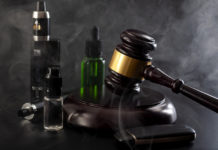Back in the 1990s, the FDA attempted to assert that it had the power to regulate nicotine as a drug but in the FDA v. Brown & Williamson Tobacco Corp., the Supreme Court ruled that the FDA lacked this authority and that Congress had passed “tobacco-specific legislation [that] effectively ratified the FDA’s previous position that it lacks jurisdiction to regulate tobacco.” It was not until the 2009 Family Smoking Prevention and Tobacco Control Act that the FDA was given the the authority to regulate tobacco products.
Currently, the Federal Food, Drug and Cosmetic Act (FDCA) defines tobacco products a being, “any product made or derived from tobacco that is intended for human consumption, including any component, part, or accessory of a tobacco product.” 21 U.S.C. § 321(rr)(1). On its website, the FDA admits that “it’s possible that a disposable, closed system device that contains an e-liquid with truly zero nicotine (or synthetic nicotine) would not be regulated by the FDA as a tobacco product.”
If given the power to regulate synthetic nicotine, the FDA could do so in several ways. It could regulate synthetic nicotine as a component of a tobacco product or it could choose to regulate synthetic nicotine as a drug. By the FDCA’s definition of a tobacco product, a component can include everything from batteries and coils to ingredients used in the production of an e-liquid. The FDCA’s definition of a drug as being “articles (other than food) intended to affect the structure or any function of the body.” 21 U.S.C. § 321(g)(1).







